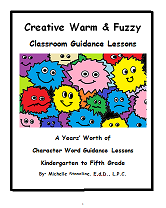Writer in Residence
Briana Cowles
Neuroscience Major
Meet our writer in residence Briana Cowles. Briana is a neuropsychology major who has offered to write for the Creative Counseling 101.com website.
Her main objective is to help bridge the gap between mental health professionals (Counselors, Psychologists, Social Workers, Therapists, Psychiatrists, etc.) and Neuroscience research.
Ms. Cowles has an impressive voice in her writing technique that I think our readers will appreciate. We will be posting her research papers on the site to help spread the word about the growing field of neuroscience and neuropsychology.
See The Effects of Chronic Illness on Couples by Briana Cowles Writer-in-ResidenceSee The Philosophy of Change in the Family Systems for Family Therapy by Briana Cowles.
Psychodynamic Therapy and Intimate Relationships
By Briana Cowles
In the psychodynamic therapy model, the primary emphasis is placed on the role of unconscious forces in the way that the couple perceives one another. This model has roots in the attachment theory and illustrates that an individual’s early experiences with a parent result in an unconscious psychological process.
In adulthood, this unconscious processing may very well form the basis of misunderstanding between partners, negative emotions, and ineffective attempts at intimacy.
Object Relations Couples Therapy is the most prominently used version of psychodynamic treatment. Here, ‘object’ references the internal representation (a working model) an individual forms of a previous caregiver- typically a parent- and it is this resulting representation that will guide and influence the nature of relationships that individual has throughout their lifetime.
Ultimately, the point of this model is that who we are as an intimate partner, has deep-seeded roots in how we have been treated by previous past relationships, particularly when we were young.
This perspective commences with the idea that parents, and caregivers in general, will vary in their ability to meet the basic needs of a developing infant, and that even the best, most established caregivers will inevitably leave the infant frustrated and disappointed at some time.
These negative, painful occurrences are registered by the infant, who represses them. This repressed experience will have strong emotional attachment- anger, longing, a craving for a more satisfying connection. Once in adulthood, these forces operate during daily exchanges.
As a part of who we are, we project these repressions from our unconsciousness onto others. Projection includes an unconscious tendency for an individual to deny their own, personal flaws, and instead locate them externally, typically by attributing them to their partner.
When in a relationship, an individual may be trapped focusing on some inadequacy in their partner- this would be a projection motivated by the feelings that are associated with the inadequate care the individual experienced as an infant.
Projective identification is how a partner will in turn respond to projections, and is pivotal to the satisfaction of relationships. If a partner displays containment- the partner takes a part of the projection and reduces the intensity of the experience; detoxifying the experience by removing the most disturbing elements- then the individual is able to take the original projection in a better form and is able to merge the new experience into a better self-image through introjective identification.
Thus, to the extent that partners are able to identify, contain, and detoxify their expressed feelings, the relationship will have to enable partners to become more adjusted to the relationship.
The primary goal of a therapist working with the psychodynamic model, particularly the object relations perspective, is to weaken the harmful effects that projection, projective interference, and introjective identification can have on the relationship.
The therapist will do this by improving the way each partner contains the other’s projections. Through the identification of ways that partners bring these unresolved early experiences into their interactions, these therapists will try to assist partners in recognizing how those experiences have clouded their abilities to provide a nurturing environment. Additionally, they may learn to free themselves from these constraints in order to have a mature and healthy relationship.
The primary emphasis of the emotion model of therapy is the manner in which different expressions of emotion can either promote or inhibit intimate bonds.
This model is unique in that emotion is the central focus in therapy. This model depicts the emotional moments in couples’ conversations and aims to create bonds. A foundation for emotionally focused therapy is that humans have a natural need for a safe and secure connection with others.
If these basic needs go unmet in a relationship, we tend to feel vulnerable and exposed. As a result, we experience distress and anxiety, and other strong primary emotions such as abandonment or shame. However, we will mask these primary emotions by displaying secondary emotions such as anger.
Negative interactions between couples are always marked by repeated displays of secondary emotions that cause a decay of trust and decrease the chance of expressing primary emotions.
An emotionally-focused therapist will work through these secondary emotions to discover and reveal the underlying primary emotions. They will then explore and expand on these emotions, while encouraging empathic responses. Ultimately, couples seeking this type of therapy will learn to express their emotions differently and therefore will have more constructive conversations. Improvement in the relationship is a result of giving the couple a new awareness of the kinds of emotional experiences they can have.
Therapists follow three distinct stages in this model: de-escalation of negative cycles, shaping new cycles of responsiveness and accessibility, and consolidation and integration. In the de-escalation stage, the therapist helps the couple acknowledge that they are both contributors to the problems in the relationship, that the underlying reaction cycle is the problem, not the partner.
The goal of this stage is to assist couples in understanding that their negative interaction cycle is driving their insecure attachment and blocking a deeper, more intimate level of emotional connection. In the shaping new cycles stages, an important transformation occurs as the partners begin to use more positive ways of understanding and approaching each other. Withdrawn partners are encouraged to express deeper primary emotions, whereas an overly critical partner is encouraged to reveal vulnerabilities.
With this new understanding, partners feel more compelled to respond more passionately and new interaction cycles begin to take place. In the final phase, consolidation and integration, the therapist works with the couple to reflect on the changes that have occurred.
Both psychodynamic and emotionally focused models appeal to me because I can see the logic behind them. The idea of internal working models and the way couple’s express emotions seem to go hand in hand to me and I can understand why these can have critical implications on a couple’s relationship.
Additionally, the treatment process seems to make the most sense to me in these models. Focusing on the how the couple expresses themselves and then reacts to their partner’s disclosures is inevitably important, so I can see how working towards changing these process can be crucial in a dissolving relationship.
Typifying Cohabitation
Casper and Sayer revealed four unique, cohabiting couple groups: precursor to marriage, coresidential daters, trial marriage, and substitute marriage. Precursor to marriage couples were the largest group, making up 46% of all couples in the study. These were partners who were currently engaged, or had seriously discussed engagement and were soon to be engaged themselves. They had moved in together as a step toward getting married.
Couples that may typify this category would be those that are committed to their relationship. They are serious about marriage and see it in their near future. Had they not decided to cohabitate they would most likely remain together until marriage, and move in together afterward.
Coresidential daters made up the next largest category with 29%. While these couples were romantically involved, they had no plans to marry and many weren’t sure if they were in a permanent relationship. The reasons they had moved in together had little to do with any serious investment in the relationship.
Couples that may typify this category would be those that are not necessarily as committed to one another. They are in a relationship, but they could potentially see other possibilities. Several had contributing factors outside the relationship for moving in together- it was financially more convenient to split rent and pay tuition.
Couples who cohabitated as a trial to marriage were those that were not engaged, and had no specific plans to get married, but they were open to the possibility and hoped that by living together it would help them determine if marriage was something they should pursue. Again, these couples are committed to one another, yet they pursue the future of their relationship with caution. The couples could be typified as “sliders,” where they’ve moved into together because they felt that’s what it was time to do, and marriage is just the next step on the road; provided living together seems to go smoothly.
Finally, the last group was those used cohabitation as a substitute to marriage. This was the smallest group on the list. These couples had absolutely no intention of ever getting engaged or married, but believed they were in a permanent relationship.
This group could be composed of a variety of different individuals- those who were in an emotionally or physically abusive previous marriage and now refuse to remarry, at the time of this study it could have been homosexual couples who were unable to get married, or it could be any number of other reasons (an elderly woman who collects the pension from her deceased husband and cannot remarry or she’ll lose his benefits).
When surveyed, people typically believe that couples who live together promote more stable marriages down the road. Cohabitating requires shared decision making, spending time together, and overall learning each other’s quirks. It can be presumed that couples who do not appreciate each other’s home lifestyles would end the relationship prior to marriage.
Despite this, studies have shown that couples who cohabit before marriage report lower marital satisfaction and higher risk of divorce. This is partially due to the selection effect, where couples who live together are typically less traditional and more open to the idea of divorce.
Selection effect, however, isn’t the whole story. Numerous studies have controlled using various methods and have shown that married couples who lived together first have more problems communicating and resolving couples. This is partially why it is necessary to understand the motives behind living together when drawing conclusions for the relationship later down the road.
Cohabitating may create its own momentum, particularly if the couple have both signed the lease and are legally obligated to the home. This can provide a barrier to the dissolution of the relationship and thus some couples may marry who otherwise would have broken up.
Cohabitating could be viewed as “sliding” into marriage- some couples may have moved in together with no intention of getting married in the future, but suddenly it seems as though it should logically be the next step. Understanding why, and typifying particular couple groups could help explain why cohabitating results in unsatisfying marriages.
Disclaimer: This website and its content is intended for trained licensed mental health professionals and school certified mental health professionals to use for their clients / students at their own discretion.
*If you ignore the disclaimer above are using these techniques on yourself and you feel any discomfort or upset it is highly suggested that you seek out a licensed mental health professional immediately.
"Beyond Art Therapy" is the concept from Dr. Stangline that combines all creative fields in therapy. It is not the traditional "art therapy" but goes beyond to include sand tray therapy, play therapy, mindfulness, meditation, color therapy, cognitive behavioral therapy, and a vast majority of other therapies.
For any other type of mental health emergency call your local 911 / Police Number immediately.
Dr. Stangline does not offer advice / suggestions to anyone who is not a professional mental health provider, or a student who is studying this field and has questions about mental health programs of study.
See our Exciting Selection of eBooks:
Award Winning:
Creative Counseling 101 eBook
Our Best Seller!
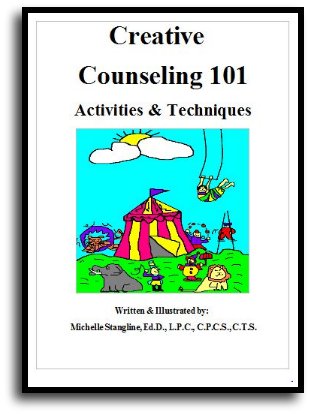
Step By Step Therapy:
Learn how to be a more Creative Therapist with the Book that started it all!
- Graduate School Counseling book used by hundreds of graduate counseling students!
- Includes full color reproducible worksheets with most activities.
- Winner of the Counselor Writer of the Year Award, 2011, Georgia Regional Award
Download Your Copy Today Only $39.95:
See Creative Counseling 101 eBook Information Here:
Get the Set
of all four
eBooks for only $98.95:
An incredible collection of how to do therapy eBooks!
A $159.80 Value,
You Save Over $60!
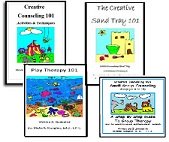
Get your complete set of the Creative Counseling 101.com eBooks by Dr. Michelle Stangline for only $98.95, that's less than $25.00 per eBook (Regular Price is $39.95 for each eBook.).
Your complete set includes:
- Creative Counseling 101
- Creative Group Counseling 101
- Creative Play Therapy 101
- Creative Sand Tray 101
For more information click the link below:
See Complete Set of eBooks For Sale Here:
New!!! "Beyond Art Therapy" 101 eBook
Over 300 pages of Beyond Art Therapy activities and techniques. Learn what I teach graduate counseling students!
See the link below for more information.
Only $39.95
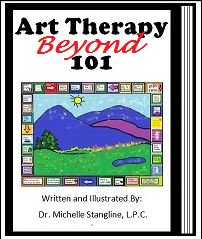
See More Invividual eBooks For Sale:
Sand Tray Therapy 101 eBook:
Learn how to do Sand Tray Therapy or enhance your skills.
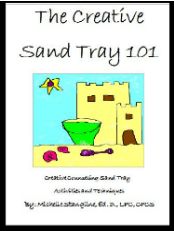
Play Therapy 101 eBook
Learn how to do play therapy or enhance your skills.
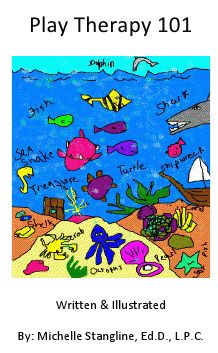
Small Group Counseling eBook For Sale:
Learn how to do creative group therapy and enhance your skills.
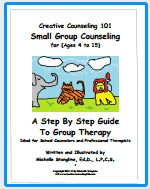
School Counselor Guidance Lesson & Social Stories eBook for sale:
Get a year's worth of school counselor guidance lessons with "Creative Warm & Fuzzy Classroom Guidance Lessons eBook". Introduce your students to the "Warm & Fuzzy Way". Click the link below for more information:
Warm & Fuzzy School Counselor Guidance Lessons eBook
